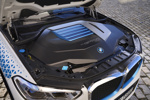THE cost of repairing damage to fleet vehicles is a multi-million pound problem for UK fleets and their vehicle suppliers.
Last year's FN50, the annual analysis of the UK's 50 largest contract hire and leasing companies, revealed that fleets were billed £90 million a year in charges by the leasing industry to pay for damage to vehicles reaching the end of their contracts.
Contract hire companies rightly expect vehicles to be returned in a good condition for their mileage, but negotiations about who pays for what are one of the biggest causes of arguments between fleets and their vehicle suppliers. They can also be a constant source of friction between fleet managers and their drivers.
In a bid to avoid some of the confusion about how much wear and tear is too much, the British Vehicle Rental and Leasing Association has re-issued its Fair Wear and Tear Guide, giving a simple pictorial guide to show drivers and fleet managers the sort of damage they can expect to receive a bill for.
The guide states: 'The aim of the BVRLA's Fair Wear and Tear Guide is to provide an industry-wide, accepted standard as to what constitutes fair wear and tear for contract- hired and leased vehicles on their return at the end of contract. Drivers and fleet operators can expect to incur refurbishment charges if a vehicle is returned with unreasonable levels of wear and tear or unrepaired damage.'
All aspects of wear and tear are covered in the guide, including body, paintwork, trim, engine and brake damage and even lost keys.
What to look for
Appearance
The vehicle's exterior should be sufficiently clean to allow a detailed inspection. The inside should be clear of rubbish and ashtrays emptied.
Damaged paint work
Repair is needed when the base coat has been penetrated. Small areas of chipping, including door edges is acceptable, relative to vehicle age and mileage.
Windscreens and windows
All glass should be kept clean. Damage in the driver's direct line of sight or affecting heating elements must be repaired immediately. Door mirrors should be kept clean.
Dents
Dents up to 10mm are acceptable if the base coat has not been penetrated and there is no corrosion. However several dents on one panel are not acceptable and will be charged for accordingly.
Scratches
Light scratches up to 25mm are acceptable as long as they have not penetrated the base coat and there is no corrosion. Scratches longer than 25mm are not acceptable.
Wheels and wheeltrims
Dents or damage to wheels, including the spare, is not acceptable. The spare wheel, jack and tools must be intact. Minor scuffing is acceptable but scoring and other damage to the wheel surface is not.
Body damage
All painted areas will be examined. Obvious evidence of poor repair is not acceptable
Upholstery
Obviously there will be some soiling, especially on the driver's seat but interior upholstery and trim must be clean with no visible burns, tears or staining. All seats which were originally supplied must be present
Appraisal tips for fleet drivers
CARRY out the appraisal 10 weeks before the vehicle is due for return. This will allow time to have undue fair wear and tear faults rectified
Appraise a vehicle as honestly as you can – be objective. Ask a friend or colleague to help
Choose a time and place with good natural daylight. This is how the leasing company will examine your vehicle. Appraisals carried out in poor light invariably miss some faults
Before appraising the vehicle make sure that is has been washed and is thoroughly clean but remember to allow time for it to dry. Water on the paintwork masks faults
Walk all the way round the vehicle and examine closely each panel including the roof, bonnet and boot/hatchback. Observe where the light is reflected differently from dents and scratches
Crouch or kneel down at the front and rear of the vehicle and look along each side. This will help pick up marks and dents that may otherwise be difficult to spot
Inspect lamps, lenses, windows and mirrors for chips, cracks or holes
Check the tyres (including the spare) for damage and that the wear on the tread across each tyre is even. Inspect wheels and wheel trims for scratches, dents or gouges
Clean and valet the interior
Check upholstered areas for tears, burns, excessive marking or wear
Inspect all controls, including audio equipment and accessories, for damage
(Source: BVLRA Fair Wear and Tear Guide)
Lex shows how not to do it
Lex Vehicle Leasing is one of Britain's biggest leasing companies and has seen its share of badly treated vehicles returned by uncaring drivers. Here are just a few:
Just before returning his van a builder decided that as the weather was inclement he would mix concrete in the back of the vehicle. Not realising the mix would set overnight the vehicle was returned with the side load door completely concreted up.
A dog owner was surprised when he left his pooch in the car for a few minutes while popping into the shop. The canine tore the car to shreds leaving little more than a small foam pad and a few coils of spring for the driver to make his uncomfortable journey back to the de-hire centre.
A human resources worker returned her car and was obviously a very heavy smoker but didn't seem to know where either the window or the ashtray was. Every inch of upholstery was covered in cigarette burns, every single piece of fabric had to be replaced.















Login to comment
Comments
No comments have been made yet.